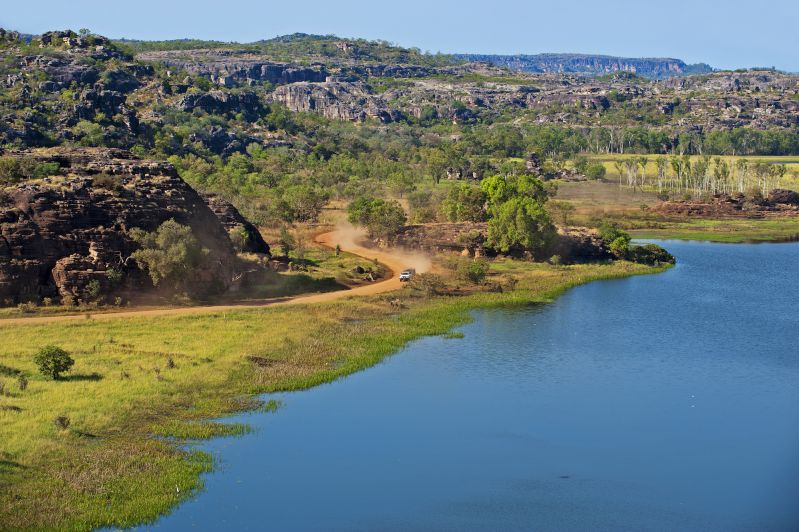Southward Gaze
Exploring Pre-Colonial Contacts Between Australia and Indonesia
Written by Leo Barry – AIYA National Blog Editor
Indonesian translation by Wes Trianugeraha – AIYA National Translation Team
Click here for Bahasa Indonesia version.
For approximately 100 years before the envoys of British imperial domination set foot on the sandy shores of Botany Bay, the Yolngu people of Arnhem land were linked to the Bugis people of Makassar, South Sulawesi through the trade of a humble item of fodder: the sea cucumber, or trepang in Indonesian. Riding the north-west monsoon winds around December each year fleets of Makassan perahu arrived on the coast of Arnhem Land. There Makassan sailors established settlements to trade tobacco, iron tools, alcohol, and cloth with the local Yolngu people for trepang. Once the rains ceased some months later processed cargoes of sea cucumber would be shipped and sold to Chinese merchants. The Yolngu people had become part of an extraordinary pre-modern transnational system of trade linking them with Indonesia and beyond to China.
Much of the most important accounts of the trepang trade lie firmly outside the gaze of colonialist historiography, within the rich songlines and oral traditions of the Yolngu clans of Arnhem Land. Stories within song and dance passed down from generation to generation constitute some of the richest narratives and descriptions regarding the deep ties between the two groups. Some of the strongest evidence for the Makassan-Yolngu links can be found in the vocabulary of the Yolngu Matha language (Yolŋu Matha), which possesses Malay, Javanese, Bugis, and even Portuguese words. Aspects of Indigenous ritual and religion also exist in Arnhem Land and nowhere else in Australia. This Yolngu oral history also represents, in part, one of the greatest refutations of early academic accounts of the trade.
Early academic accounts of Yolngu-Indonesian links were ultimately focused exclusively on the trade with Makassans. Australian professor Campbell Macknight’s 1976 “The Voyage to Marege” was the first piece of academic scholarship to popularise the history of Australia’s first export industry. Macknight relied upon archaeological and archival research but openly dismissed the utility of Yolngu oral tradition. His research placed the beginning of the trade and Indonesia’s presence in Australia around the 1700s. Others had come across Yolngu tales of other groups such as the Bayini and the Wurumulla, separate peoples believed by the Yolngu to have visited and settled in Arnhem land before the Makassans. These groups however, occupied the grey area so endemic to oral history between history and myth, between fact and fable. The Wurumulla were thought by the Yolngu to have come from the ‘land of the dead,’ and the Bayini from the moon. Both anthropologists, thus fell victim to the colonial conceit; history is only worth the paper it’s written on. The Wurrumulla and Bayini as such were not treated with the effort they deserved and their existence remained relegated to the category of Western academic classification of folklore and myth.
In 2013 a peculiar rock painting near Cape Wessel in North-East Arnhem Land became the first “tangible” piece of evidence for the existence of pre-Makassan visitors to the Australian continent. The painting depicts a double-outrigger ship entirely dissimilar from any Makassan perahu, resembling rather a ship from the Maluku area of Indonesia. Another rock art painting on the Wessel Islands depicts what seems to be an outstandingly accurate map of the Indonesian island of Banda, also located in Maluku. Over many years American anthropologist Ian Mcintosh has worked hard to synthesise Yolngu oral tradition to rightfully incorporate its perspective within history. His work has produced remarkable results, overturning the accepted academic narrative of Australia’s first connections with the outside world.
Publishing a string of papers and essays over many decades while working closely with Yolngu elders as well as founding a group of anthropologists and archaeologists named “Pastmasters” dedicated to the study of Arnhem Land’s history, Mcintosh has convincingly demonstrated that Arnhem Land had enjoyed not one but three waves of pre-colonial Indonesian migration. All three waves were characterised by different relationships with Arnhem Land’s First Nations people, ranging from “reciprocity to patterns of abuse and domination.” These widely varying relationships are clearly embedded in Yolngu language, custom, and art, and patently undermine previously simplistic conceptions of these pre-colonial links. Some of Mcintosh’s assertions include the existence of three distinct waves of Indonesian contact: first the Wurrumula, then the Bayini, and finally the Makassans, as well as the hypothesised founding of a military base by fleeing members of the conflict between the Dutch and Gowa-Tallo Sultanates on Australia’s shores in the 1660s.
Through this engagement with rich Yolngu oral tradition McIntosh has gained remarkable insight into the history of their contacts with the outside world that in their pride, many previous anthropologists simply ignored. This work recognises the legitimacy of Indigenous oral history using approaches that create an anti-colonial historiography that induce superior results in the recreation of our past. It is a shame however that it has taken the work of non-Indigenous people to get.
In September 2022, an Australian Yolngu musical group called ‘Ngulmiya’ visited Indonesia to play at Borobudur temple in Central Java as part of Australia’s cultural delegation to last year’s G20 event. They performed their song “Red Flag,” or “Dharrimana” in Yolngu Matha where presence of the Bahasa Indonesia phrase “dari mana” or “where are you from?” can be instantly recognised.This legacy of Indonesian influence on Arnhem Land continues to still be remarkably clear today.
On his Pastmaster’s website McIntosh writes:
“It is now evident that the artificial line demarcating zones of belief and influence between Australia and Indonesia, long advocated (for) in the anthropological and archaeological literature, should now be erased.”
It is important to consider that Indonesia and Australia’s differing colonial histories have created an artificial distinction between our own countries’ past. If both changed the approach we use to look at our nation’s histories, we might find that they are not so different after all.

